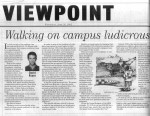It’s Thursday and I’ve somehow taken an Uber to campus five times this week in a panicked rush.
I think I should be more ashamed of my excess – after all, I am not the sharing economy’s biggest fan and my weekly failure to go to the John Wooden Center means running late to class is my primary source of exercise – but I’m not. I’m just tired. Between editing for The Bruin, sometimes going to class and running an unending list of errands, hitting the request button hardly feels like an indulgence.
You don’t have to look far back to find similar frustration. On April 20, 2005, Viewpoint columnist David Keyes wrote about the “living hell” of having to walk everywhere on campus before offering a list of investments UCLA could make to become “the modern campus-transport capital of the world.”
On-campus transport is no longer the problem in 2015, though that’s not to say it’s gotten any easier to keep climbing hills. Instead, students need more help escaping the Westwood bubble than they do getting to class.
“We have wasted much of our college lives mindlessly walking,” Keyes writes.
His suggestions, including a zipline from Hedrick Hall to Bunche Hall and “Janss Escalators,” would have added whimsy to the slow, monotonous march students make to lecture while subtracting precious minutes spent walking from their on-campus commutes.
Ten years later, though, and Keyes’ complaints about communal campus transport – primarily bus and van services – have been mostly addressed by UCLA Transportation. He claimed bus and van services were ineffective because of inconvenient times, inconvenient routes and poor advertising.
To be fair, the situation was bleak at the time, but in 2010, UCLA Fleet and Transit re-branded the UCLA bus service, introducing real-time updates on bus arrivals online and by phone and titling it Bruin Bus. Since then, the fleet has also added new routes and received additional funding – though unfortunately at the expense of higher-priced parking permits.
The Community Service Officer van service has similarly improved since the turn of the decade, extending its coverage and ditching fixed routes for flexible service.
These options supplement the variety of individual choices students can make to accelerate their pace, but none of them help students access the Greater Los Angeles area. The city’s trying, though, and working on developments like extending the Purple Line to Westwood and restructuring street-planning policy to improve mobility. It’s really only a matter of time and endless bureaucracy before students can mindlessly walk through Los Angeles with the same ease they do on campus.
Until then, some students will continue to use their boards, bikes and scooters to whiz past others down Bruin Walk. They’ll even Uber or “hoverboard” to class in pursuit of some extra time – to sleep, to study, to party, to do every one of the innumerable things youth demands.
Everything, except maybe get downtown.
